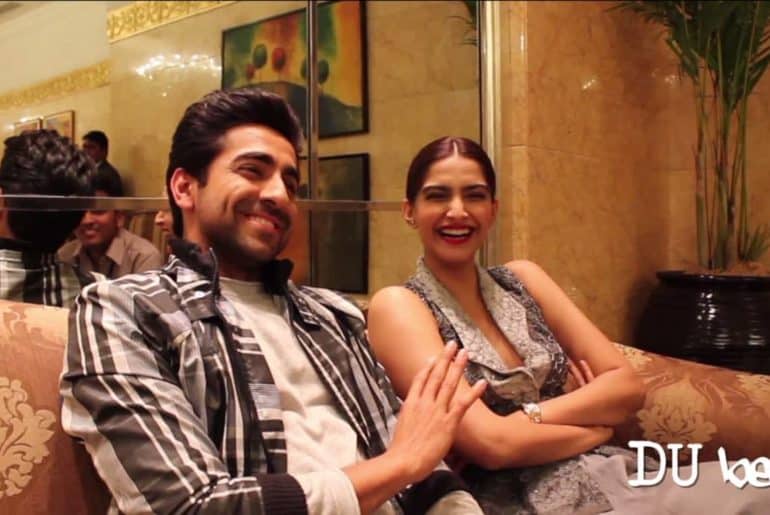From talking about the “bewakoofiyan” they did in college, to exploring the urban and corporate side of Delhi with their upcoming movie Bewakoofiyan, we sat down with Ayushmann Khurrana and Sonam Kapoor recently. Hear them speak about love during recession and the experience of working together as co-stars for the first time. Plus, Sonam gives our readers some tips on budget fashion and questions the radicalism of Ayushmann’s dressing sense.
Presenting Sonam Kapoor and Ayushmann Khurrana in conversation with our correspondents Ishika Gupta and Iresh Gupta (Videographed by Abhinav Arora).
Ishika : Tell us something about Bewakoofiyan and what is it that students will love about your movie?
Sonam : This story is about how love is more important than materialistic needs. Sometimes you get to relationships or get married to people for various reasons like money, job or education. But sometimes you need to be with someone because you love them, because they make you happy and he/she is a nice person. And I think that is the most important thing and at the same time very basic and simple. But kids or young people these days are actually forgetting that. They get to relationships saying that “She is hot” or “She is sexy.”
Ayushmann : (laughs) Sketch of the film is that this guy (points toward himself) is jobless. And his girlfriend earns more than him and she is hot. The father has a problem with that, of course. The sketch is very simple but the story is unusual, it is realistic. It is not those typical rom-com movies. It is based on recession.
Iresh : This is a very unique pairing for the movie. You guys have been paired for the first time together. So how was it working with each other? Like comparing to your co-stars in the past?
Ayushmann : TERRIBLE! It was really bad… It is the first time I am working with a star. I have worked with debutants in the past. Yes, of course she is a star! Lets be straight now. Earlier I thought she is a fashion icon, so the pairing will be quite odd and unusual with I being a guy next door and she being a fashion icon but when I got to know her, personally I got to know that she is very simple, sweet and sorted and she has seen life so I have learned a lot from her, not only how to be on camera but also how to be off camera.
Sonam : (hugs Ayushmann) Okay, honestly it was amazing working with him. Actually, I have never had the same co-star in any film. Everytime I do a film it is someone else. So how is it working with him? The only person I have worked with twice is Abhishek (Bachchan). One was Delhi 6, the other one was this not so happening film, Players. Everybody else has been new. I have worked with 10 different heroes. (laughs) So yeah. He is awesome.
Ishika : As we grow old, we get freedom. With that comes a lot of responsibility and we get a lot of chance to exploit that responsibility. So what were the bewakoofiyaan that you did when you were in college?
Sonam : I only studied till the 12th. Unfortunately I could do bewakoofi only till high school. After that I started working. The biggest bewakoofi I have done in my life is not going to college. So people who are in college, please go to college.
Ayushmann : Bewakoofi in school, having crushes on teachers and seniors. That was crazy. The feelings are not mutual, so that’s the biggest bewakoofi. Apart from that, being an actor is also a bewakoofi. It is quite under weighed for someone who is not from the industry and is unaware about the frills of the industry. When people are judgemental, you have to be a master and completely in control of your head to be an actor. It is very difficult.
Iresh : You both came to SRCC to promote your film, so how was the experience in the university? Or Delhi as a whole, as the movie is majorly shot in Delhi and Gurgaon apart from Dubai?
Ayushmann : I was back with a bang in Delhi. It was my third film in Delhi. The city has a lot of character. There is Old Delhi and New Delhi. Jaise vicky donor purani delhi ki thi, yeh nayi dilli ki film hai. It is more urban. This is the first time we are exploring the urban side of Delhi, its corporate side like Gurgaon and Cyber.
Ishika : When we are in college we have a very minimal budget and everyone wants to look good. So what advice will you give to the students about budget fashion?
Sonam : Go to Dilli Haat, pick up every accessory possible for 100-200 bucks, get a kurta or anything from any of the markets and accessorize yourself and you will look beautiful. I think so. I guess it is all about mixing and matching, being artistic, being yourself and having an expression.
Ayushmann : I don’t know if I should talk about fashion or not. Fashion for me is a mood swing. If you feel like an introvert one day, you can be in jeans and a t-shirt. If you feel like radical or an extrovert one day, you can be radical to fashion. I am only radical when I am with Sonam. Otherwise I am okay with my jeans and t-shirt. When you are with Sonam, you have to make an appearance. There is an extra pressure to look good.




